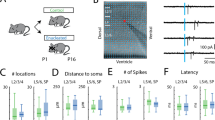Abstract
THE connections between the eyes and the brain are so arranged as to give an orderly representation in the brain, of the visual field. The mechanisms involved in this ordering have been extensively studied, particularly in the retinotectal pathway of submammalian vertebrates1–3. In these species the optic nerves decussate almost completely, retinal ganglion cells in one eye connecting only with the opposite tectum. In mammals, however, there is partial decussation at the optic chiasma, so that the superior colliculus receives optic fibres from both eyes. Binocular representation poses a problem for the ordering of retinotectal projections. If one point on the tectum is to correspond to only one point in visual space, seen through both eyes, the mapping rules onto the tectum must have opposing polarities in the two eyes, along the nasotemporal axis. This is shown in Fig. 1 : a rostral movement in the colliculus corresponds to a temporal movement on the contralateral retina but a nasal movement on the ipsilateral retina. Little is known about the factors determining the topography of the direct ipsilateral projection to the mammalian superior colliculus. Anatomical studies in rodents have shown that neonatal removal of one eye induces an increased projection from the remaining eye to the ipsilateral colliculus4,5. These aberrant uncrossed optic fibres are derived from all regions of the retina and apparently have a distribution appropriate for a normal contralateral projection, that is, the nasotemporal retinal axis is represented caudorostrally6. The only published physiological study investigating the topography (in enucleated rats) confirmed the anatomy as regards the nasotemporal axis but, surprisingly, found the dorsoventral axis reversed over most of the colliculus ipsilateral to the remaining eye7. Here I present results on the enucleated hamster showing that the colliculus ipsilateral to the remaining eye contains a double representation of the visual field displaying mirror-image polarity along the nasotemporal axis.
This is a preview of subscription content, access via your institution
Access options
Subscribe to this journal
Receive 51 print issues and online access
$199.00 per year
only $3.90 per issue
Buy this article
- Purchase on Springer Link
- Instant access to full article PDF
Prices may be subject to local taxes which are calculated during checkout
Similar content being viewed by others
References
Gaze, R. M. The Formation of Nerve Connections (Academic, London, 1970).
Keating, M. J. in Neural and Behavioural Specificity (ed. Gottlieb G.), 59–110 (Academic, New York, 1976).
Lund, R. D. Development and Plasticity of the Brain. An Introduction (Oxford University Press. New York, 1978).
Lund, R. D., Cunningham, T. J. & Lund, J. S. Brain behav. Evolut. 8, 51–72, (1973).
Frost, D. O. & Schneider, G. E. Neurosci. Abstr. 2, 812, (1976).
Lund, R. D. & Lund, J. S. J. comp. Neurol. 169, 133–154 (1976).
Cunningham, T. J. & Speas, G. Brain Res. 88, 73–79 (1975).
Lund, R. D. Expl Eye Res. 21, 193–203 (1975).
Tiao, Y.-C. & Blakemore, C. J. comp. Neurol. 168, 459–482 (1976).
Merrill, E. G. & Ainsworth, A. Med. biol. Engng 10, 662–672 (1972).
Tiao, T.-C. & Blakemore, C. J. comp. Neurol. 168, 483–504 (1976).
Chalupa, L. M. & Rhoades, R. W. J. Physiol., Lond. 270, 595–626 (1977).
Rhoades, R. W. & Chalupa, L. M. J. comp. Neurol. (in the press).
Findlay, B. L., Schneps, S. E., Wilson, K. G. & Schneider, G. E. Brain Res. 142, 223–235 (1978).
Guillery, R. W. & Kaas, J. H. J. comp. Neurol. 143, 73–100 (1971).
Weber, J. T., Kass, J. H. & Harting, J. K. Brain Res. 148, 189–196 (1978).
Lund, R. D., Lund, J. S. & Wise, R. P. J. comp. Neurol. 158, 383–404 (1974).
Levine, R. L. & Jacobson, M. Brain Res. 98, 172–176 (1975).
Glastonbury, J. & Straznicky, K. Neurosci. Lett. 7, 67–72 (1978).
Lund, R. D. J. Anat. 100, 51–62 (1966).
Garey, L. J., Jones, E. G. & Powell, T. P. S. J. Neurol. Neurosurg. Psychiat. 31, 135–57 (1968).
Berman, N. & Cynader, M. J. Physiol. Lond. 245, 261–270 (1975).
Cunningham, T. J. & Freeman, J. A. J. comp. Neurol. 172, 165–176 (1977).
Cunningham, T. J. Science 194, 857–859 (1976).
Author information
Authors and Affiliations
Rights and permissions
About this article
Cite this article
THOMPSON, I. Changes in the uncrossed retinotectal projection after removal of the other eye at birth. Nature 279, 63–66 (1979). https://doi.org/10.1038/279063a0
Received:
Accepted:
Issue Date:
DOI: https://doi.org/10.1038/279063a0
This article is cited by
-
Restricted perinatal retinal degeneration induces retina reshaping and correlated structural rearrangement of the retinotopic map
Nature Communications (2013)
-
Retino-fugal projections in congenitally monophthalmic fish and anurans
Cell and Tissue Research (1991)
-
Ganglion cell death during development of ipsilateral retino-collicular projection in golden hamster
Nature (1984)
Comments
By submitting a comment you agree to abide by our Terms and Community Guidelines. If you find something abusive or that does not comply with our terms or guidelines please flag it as inappropriate.



